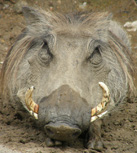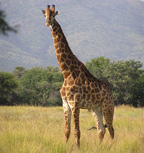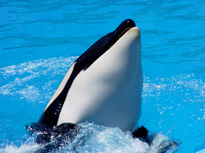Cetartiodactyla -- Ruminants, grazers, and generally decent folk!



Origins
The name of this order came about when Cetacea (large sea creatures) and Artiodactyla( artios=complete and daktulos=toes in Greek) were merged together because it is now thought that whale ancestors were quite like even-toed herbivores. One day (geologically speaking, it was a few million years) early Cetaceans just walked into the water,found it quite exhilarating, and stayed there.
Artiodactyla arose at the end of the dinosaur era, when the great herbivorous reptiles died out and the earth's forests thinned to become massive grasslands. It is proposed that some ancestors of the hippopotami ventured further onto land and became adept runners and grazers.
What are they like?
Cetartiodactyla are so named because they rest their weight on the hoofs( the nail of the toes) in a way that the center line passes through the two middle digits( III and IV). Why is this relevant or even important, you might ask? You see, these creatures literally survive by being able to run well and so the way they balance themselves matters when we try to understand their lives. Two main types of foot structure are recognized: a "cloven hoof" with two weight-bearing toes, and a spreading foot with four digits. In all cases the third and fourth digits are well developed, while the second and fifth are reduced or absent.
The Cetaceans are a special case within this group because they have evolved such wonderful swimming abilities that their resemblance to terrestrial cousins cannot be easily recognized. Plus they have no balance or cloven hoofs to worry about. They rely on modified feet called flippers to get around and blubber to keep warm in the cold environments that they usually inhabit. They have also evolved to become large. The blue whale has become so large that it is now recognized as the largest creature that has ever lived. Dinosaurs, take that!
Geographic Distribution
These creatures have colonized all the seas and all the lands apart from Antarctica and Australia. They are extremely necessary for human survival as they have been the basis on which all civiliaztions have been built. Without this order of mammals humans would probably still be hunter-gatherers in isolated communities around the world.
Reproduction
The animals in this order live in large social groups of females and young for security against predators. Males are bigger than females and need more food so they live mostly alone only coming together for mating. Females give birth to young and take care of them until they are weaned. Very rarely do these animals give birth to more than one young at a time.
Feeding Habits
Almost all species within this order eat grass. They have large stomach and complex digestive systems that help them get the maximum nutrition from this very poor resource. Try eating wild grass for a day and see how hungry you become? On second thought, don't! You will just get hungry and sick! You are human and not built to handle such food.
Families within artiodactyla
Antelocapridae(Pronghorns)
Neobalaenidae(Pygmy Right Whales)
Eschrichtiidae(Gray Whales)
Platanistidae(Ganges Dolphin)
Moschidae(Musk Deer)
Suidae(Pigs & Boars)
Tayassuidae(Peccaries)
Hippopotamidae(Hippos)
Camelidae(Camels & Llamas)
Tragulidae(Chevrotains)
Servidae(Deer)
Giraffidae(Giraffes & Okapi)
Antelocapridae(Pronghorns)
Bovidae(Cattle, Antelope, Sheep & Goats)
Lipotidae(Yangtze Dolphin)
Iniidae(Amazon Dolphin)
Pontoporiidae(Franciscana Dolphins)
Delphinidae(Dolphins)
Phocoenidae(Porpoises)
Monodontidae(Narwhal & Belugas)
Physeteridae(Sperm Whales)
Kogiidae(Pygmy Sperm Whales)
Ziphiidae(Beaked Whales)
Balaenopteridae(Rorquals)
Balaenidae(Right Whales)
Videos
References
The Department of Paleantology at UC Berkeley
Wikipedia
Animal Diversity Web
What is an ungulate?
The Princeton Encyclopedia of Mammals